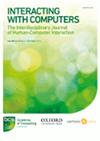反馈类型对年轻用户和老年用户触摸屏导航的影响
IF 1
4区 计算机科学
Q3 COMPUTER SCIENCE, CYBERNETICS
引用次数: 0
摘要
本研究调查了不同模式的反馈如何影响年轻和年长用户在触摸屏上完成窗口导航任务。32 名年轻用户和 32 名老年用户在无反馈或视觉、触觉或视觉-触觉反馈的情况下,将窗口移向四个或八个目标区域中的一个。与触觉反馈相比,视觉反馈的准确率明显更高,任务完成时间也更短。一般来说,视觉-触觉反馈并不比视觉反馈产生更高的准确率或更短的任务完成时间。不过,视觉-触觉反馈可以防止年轻和年长的用户过度点击窗口。此外,当用户试图将窗口移动到八个目标区域之一时,视觉-触觉反馈有助于年轻用户更好地完成任务。根据人类处理理论,视觉-触觉反馈之所以具有微妙的优势,是因为在窗口导航过程中,与直观的视觉信息相比,不直观的触觉力会引起更高的认知负荷。尽管如此,根据情绪和疲劳、手势可用性和偏好等方面的问卷调查,视觉触觉反馈仍能给用户带来最佳体验。此外,与年轻用户相比,更多的老年用户更喜欢视觉触觉反馈。因此,在窗口导航任务中应考虑视觉-触觉反馈,并对触觉反馈进行修改,使其更加直观。研究亮点 在窗口导航任务中,视觉反馈比触觉反馈更能提高任务表现。与视觉反馈相比,视觉-触觉反馈不能提高任务绩效。视觉-触觉反馈可防止用户过度点击窗口。与年轻用户相比,更多的老年用户更喜欢视觉触觉反馈。本文章由计算机程序翻译,如有差异,请以英文原文为准。
Effects of Feedback Type on Touchscreen Navigation for Younger and Older Users
This study investigates how feedback from different modalities affect window navigation tasks performed on a touchscreen by younger and older users. Thirty-two younger and 32 older users moved a window toward one of four or eight target areas with no feedback or visual, tactile or visual–tactile feedback. Visual feedback produced significantly higher accuracy and shorter task completion times than tactile feedback. Generally, visual–tactile feedback did not produce statistically higher accuracy or shorter task completion time than visual feedback. However, visual–tactile feedback prevented both younger and older users from overshooting the windows. Additionally, when users attempted to move the window to one of the eight target areas, the visual–tactile feedback helped younger users perform better. According to theories about human processing, the reason for the subtle advantage of visual–tactile feedback is that the unintuitive tactile force induces a higher cognitive load than straightforward visual information during window navigation. Nevertheless, visual–tactile feedback elicited the best user experience, as measured by questionnaires on emotion and fatigue, gesture usability and preference. Furthermore, more older users prefer visual–tactile feedback than younger users. Therefore, visual–tactile feedback should be considered, and the tactile feedback should be modified to be more intuitive in window navigation tasks.
Research Highlights Visual feedback improved task performance more than tactile feedback in window navigation task. Visual–tactile feedback did not improve task performance compared to visual feedback. Visual–tactile feedback prevented users from overshooting the window. More older users than younger users prefer visual–tactile feedback.
求助全文
通过发布文献求助,成功后即可免费获取论文全文。
去求助
来源期刊

Interacting with Computers
工程技术-计算机:控制论
CiteScore
2.70
自引率
0.00%
发文量
12
审稿时长
>12 weeks
期刊介绍:
Interacting with Computers: The Interdisciplinary Journal of Human-Computer Interaction, is an official publication of BCS, The Chartered Institute for IT and the Interaction Specialist Group .
Interacting with Computers (IwC) was launched in 1987 by interaction to provide access to the results of research in the field of Human-Computer Interaction (HCI) - an increasingly crucial discipline within the Computer, Information, and Design Sciences. Now one of the most highly rated journals in the field, IwC has a strong and growing Impact Factor, and a high ranking and excellent indices (h-index, SNIP, SJR).
 求助内容:
求助内容: 应助结果提醒方式:
应助结果提醒方式:


